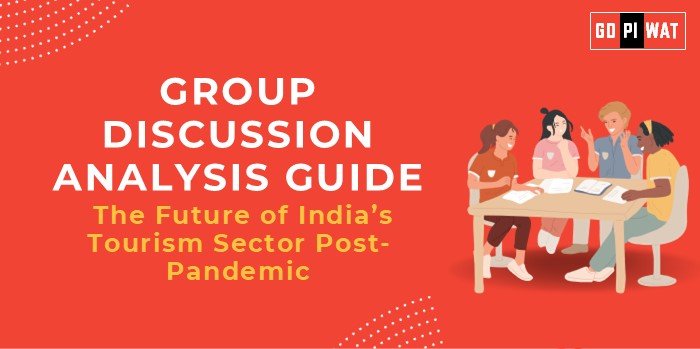📋 Group Discussion Analysis Guide
🌏 Topic: The Future of India’s Tourism Sector Post-Pandemic
🌟 Introduction
- Contextual Opening: “India’s travel and tourism sector, once contributing a significant 9.2% to GDP in 2019, faced unprecedented challenges during the COVID-19 pandemic. However, with a shift towards domestic tourism and the support of digital innovation, the sector stands at a pivotal point of transformation.”
- Background: As the world adapts to post-pandemic norms, India’s rich cultural and ecological diversity provides a foundation for revitalizing tourism through sustainable practices and infrastructure improvements.
📊 Quick Facts & Key Statistics
- Pre-Pandemic Contribution: 9.2% of GDP in 2019 (WTTC) – Highlights tourism’s critical economic role.
- Job Losses: 21.5 million jobs lost during COVID-19 – Underlines the sector’s vulnerability.
- Domestic Tourism Recovery: Accounted for 83% of tourism spending in 2019, projected to rise to 89% by 2028 (WTTC) – Emphasizes the focus on local markets.
- E-Visa Uptake: Over 2 million e-Visas issued in 2019, streamlining international travel.
🔑 Stakeholders and Their Roles
- Government: Policy creation, promoting domestic and international tourism, and infrastructure development.
- Private Sector: Hospitality and travel services are driving innovation and customer experiences.
- Local Communities: Preserve cultural heritage and engage in sustainable tourism.
- Tourists: Create demand for new experiences and responsible tourism.
- Global Organizations: Facilitate recovery frameworks and set international best practices.
🏆 Achievements and Challenges
-
Achievements:
- Digital Advancements: E-visa adoption simplified entry for international tourists, boosting inflow.
- Domestic Resilience: Domestic travel accounted for 83% of tourism spending in 2019, with further growth expected.
- Eco-Tourism Initiatives: Programs in states like Sikkim have set benchmarks for sustainable tourism.
-
Challenges:
- Job Recovery: 21.5 million job losses during the pandemic require strategic intervention.
- Infrastructure Gaps: Insufficient connectivity in rural and remote areas.
- Sustainability Concerns: Over-tourism and climate risks threaten iconic sites.
💬 Effective Discussion Approaches
-
Opening Approaches:
- Quote pre-pandemic contributions to GDP and highlight post-pandemic recovery trends.
- Mention the rapid rise of domestic tourism as a key driver of resilience.
-
Counter-Argument Handling:
- “The loss of 21.5 million jobs highlights the need for targeted government schemes.”
- “Innovative measures like e-Visas showcase adaptability in tourism recovery.”
🔍 Strategic Analysis of Strengths & Weaknesses
- Strengths: Cultural and ecological diversity, strong domestic tourism trends.
- Weaknesses: High dependence on seasonal and international travel, inconsistent infrastructure in rural regions.
- Opportunities: Promote wellness and spiritual tourism, leverage AI and big data for personalized experiences.
- Threats: Competition from neighboring countries, environmental degradation of heritage and natural sites.
💡 Structured Arguments for Discussion
- Supporting Stance: “India’s tourism sector is uniquely positioned to lead globally with its rich heritage and domestic travel boom.”
- Opposing Stance: “Persistent issues like inadequate infrastructure and job losses slow the recovery momentum.”
- Balanced Perspective: “While the domestic sector shows promise, a comprehensive approach addressing sustainability and international marketing is essential.”
📚 Connecting with B-School Applications
-
Real-World Applications:
- Projects on digital transformation in tourism.
- Case studies on job recovery in high-impact sectors.
-
Sample Interview Questions:
- “How can e-visas enhance India’s global tourism appeal?”
- “What role does domestic tourism play in economic recovery?”
- Insights for Students: Explore strategies for balancing economic growth with sustainability. Research the impact of digital tools on tourism experiences.


